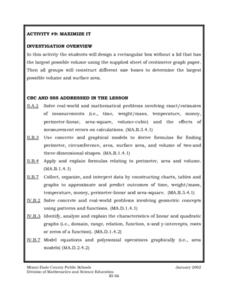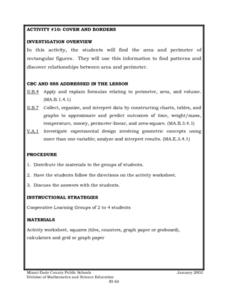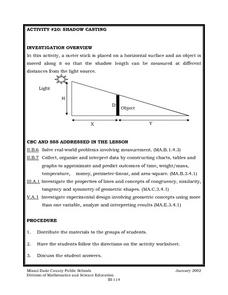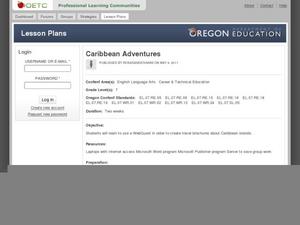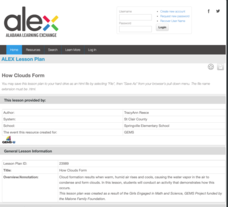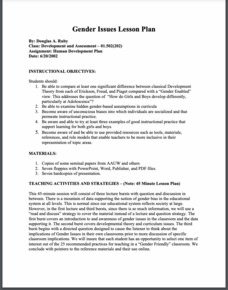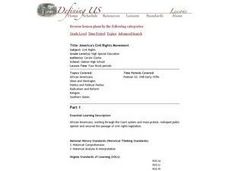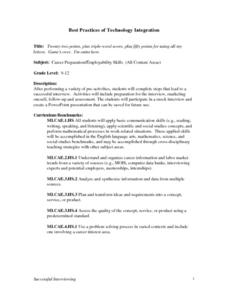Curated OER
Archimedes' Principle of buoyancy
Students use the internet to research Archimedes' principle of buoyancy. In groups, they summarize the principle and share it with the class. They also participate in experiments in which they test the principle and share their results...
Curated OER
Maximize It!
Students design a rectangular box without a lid that has the largest possible volume using the supplied sheet of centimeter graph paper. They work in groups to construct different size boxes to determine the largest possible volume and...
Curated OER
Political statements and protected speech
Learners research and investigate what laws exist about freedom of speech. They write an article about this topic. Students interview the learners at their school on this topic. They take a stand and support their stand with facts.
Curated OER
Characteristics of Anne Frank
Eighth graders read selected passages from The Diary of Anne Frank. Working in pairs, 8th graders determine what qualities and characteristics they would assign to her from their selected diary entry.
Curated OER
Cover and Boarders
Young scholars find the area and perimeter of rectangular figures. They use this information to find patterns and discover relationships between area and perimeter. Students apply and explain formulas relating to perimeter, area, and...
Curated OER
Shadow Casting
Eighth graders use a meter stick that is placed on a horizontal surface and an object is moved along it so that the shadow length can be measured at different distances from the light source. They solve real-world problems involving...
Curated OER
George Winter Lesson Plan 3
Bring language arts and U.S. history together in this lesson, which prompts middle and high schoolers to gather biographical information about Abraham Lincoln. They compare and contrast information written about his childhood and discuss...
Curated OER
Caribbean Adventures: Research and Desktop Publishing
If you want an interesting way to teach about the Caribbean that incorporates technology, this might be your answer. Class members conduct a WebQuest to gather information about Caribbean islands and create a travel brochure using...
Alabama Learning Exchange
How Clouds Form
Young scholars analyze how clouds form. In this cloud formation lesson, young scholars brainstorm types of clouds and what they think they're made of. Young scholars conduct an experiment to see how clouds form and discuss their...
Curated OER
Brain Power
Middle schoolers study the brain and how it performs the memory function. In this brain power lesson students complete a memory activity.
Curated OER
Gender Issues Lesson Plan
Students examine gender biases. In this educational issues lesson plan, students participate in activities that require them to analyze gender issues in the classroom and challenge to break out of the mode.
Curated OER
Regions of the United States
Fifth graders collect data about regions of the United States using the Internet, library books, and encyclopedias. They write an essay persuading people to visit their state.
Curated OER
Teaching and Learning Through Objects
Students identify and interpret the function, usefulness or utitlity, form, beauty or aesthetics, and meaning, context or story, of objects and how they learn new skills and make things that they learn traditionally, by observation and...
Curated OER
Frog and Toad Are Friends
Second graders complete pre reading, writing, during reading, and interdisciplinary activities for the book Frog and Toad are Friends. In this reading lesson plan, 2nd graders complete journal entries, go over vocabulary, answer short...
Curated OER
Watching Minds Bloom
Educators can use the Principles of Bloom's Taxonomy as a Guideline for Differentiated Instruction.
Curated OER
Backyard Critters
Students explore the characteristics of invertebrates in their backyards. They observe, describe, and classify specimens. They conclude with a "snail race."
Curated OER
Revolutionary War
Students identify and research significant people, causes, and primary documents of the U.S. Revolutionary War. They create a class Revolutionary War web using Inspiration computer software, write a journal depicting three days in the...
Curated OER
America's Civil Rights Movement
Eleventh graders explore, analyze and study the background to America's Civil Rights Movement through the court system, mass protest, public opinion, political cartoons and legislation. They research Rosa Parks, Brown vs. Board of...
Curated OER
A Plane Old Time
Fourth graders become familiar with a chart and use the information to create a flight plan. In this flight plan lesson plan, 4th graders access background knowledge of the role of flight controllers and the number concepts they...
Curated OER
Unlikely Communicators: Carrier Pigeons
Second graders explore information about carrier pigeons and other means of communication. They describe different types of communication and transportation and identify their advantages and disadvantages They develop a Communication...
Curated OER
To Float or Not to Float, That is the Question?
Ninth graders develop operational definition of density, do computations using density equation, categorize pieces of matter as being able to float on
water or not, based on density, explain why some objects sink or float based on...
Curated OER
Successful Interviewing
After performing a variety of pre-activities, students will complete steps that lead to a successful interview. Activities will include preparation for the interview, marketing oneself, follow-up and assessment. The students will...
Curated OER
Cardiac Arrest! Using Forensics to Investigate Cardiovascular Anatomy and Function
Students identify the different parts and functions of the cardiovascular system. In this forensics lesson, students collect and analyze evidence on a fictional crime. They describe different causes of cardiac arrest.
Curated OER
Is the Hudson River Too Salty to Drink?
Students explore reasons for varied salinity in bodies of water. In this geographical inquiry lesson, students use a variety of visual and written information including maps, data tables, and graphs, to form a hypothesis as to why the...

